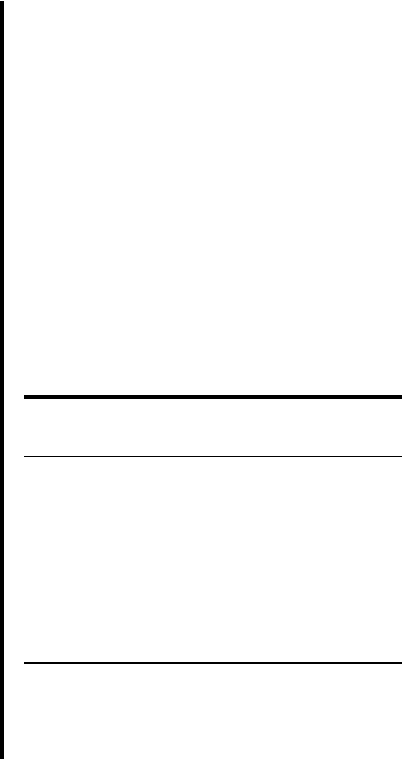Daniel W.W. Biostatistics: A Foundation for Analysis in the Health Sciences
Подождите немного. Документ загружается.


be equal to zero for each pair of observed and expected frequencies. Such a result would
yield a value of equal to zero, and we would be unable to reject
When there is disagreement between observed frequencies and the frequencies one
would expect given that is true, at least one of the terms in Equation 12.2.4
will be a nonzero number. In general, the poorer the agreement between the and the
the greater or the more frequent will be these nonzero values. As noted previously,
if the agreement between the and the is sufficiently poor (resulting in a sufficiently
large value,) we will be able to reject
When there is disagreement between a pair of observed and expected frequencies,
the difference may be either positive or negative, depending on which of the two frequen-
cies is the larger. Since the measure of agreement, is a sum of component quantities
whose magnitudes depend on the difference positive and negative differences
must be given equal weight. This is achieved by squaring each difference. Divid-
ing the squared differences by the appropriate expected frequency converts the quantity
to a term that is measured in original units. Adding these individual terms
yields a summary statistic that reflects the extent of the overall agreement between
observed and expected frequencies.
The Decision Rule The quantity will be small if the observed
and expected frequencies are close together and will be large if the differences are large.
The computed value of is compared with the tabulated value of with
degrees of freedom. The decision rule, then, is: Reject if is greater than or equal
to the tabulated for the chosen value of
Small Expected Frequencies Frequently in applications of the chi-square
test the expected frequency for one or more categories will be small, perhaps much less
than 1. In the literature the point is frequently made that the approximation of to
is not strictly valid when some of the expected frequencies are small. There is disagree-
ment among writers, however, over what size expected frequencies are allowable before
making some adjustment or abandoning in favor of some alternative test. Some writ-
ers, especially the earlier ones, suggest lower limits of 10, whereas others suggest that
all expected frequencies should be no less than 5. Cochran (4, 5), suggests that for good-
ness-of-fit tests of unimodal distributions (such as the normal), the minimum expected
frequency can be as low as 1. If, in practice, one encounters one or more expected fre-
quencies less than 1, adjacent categories may be combined to achieve the suggested min-
imum. Combining reduces the number of categories and, therefore, the number of degrees
of freedom. Cochran’s suggestions appear to have been followed extensively by practi-
tioners in recent years.
12.3 TESTS OF GOODNESS-OF-FIT
As we have pointed out, a goodness-of-fit test is appropriate when one wishes to decide
if an observed distribution of frequencies is incompatible with some preconceived or
hypothesized distribution.
x
2
x
2
X
2
a.x
2
X
2
H
0
k - rx
2
X
2
g31O
i
- E
i
2
2
>E
i
4
X
2
,
1O
i
- E
i
2
2
>E
i
O
i
- E
i
O
i
- E
i
,
X
2
,
H
0
.X
2
E
i
O
i
E
i
,
O
i
O
i
- E
i
H
0
H
0
.X
2
12.3 TESTS OF GOODNESS-OF-FIT
597

We may, for example, wish to determine whether or not a sample of observed val-
ues of some random variable is compatible with the hypothesis that it was drawn from
a population of values that is normally distributed. The procedure for reaching a deci-
sion consists of placing the values into mutually exclusive categories or class intervals
and noting the frequency of occurrence of values in each category. We then make use of
our knowledge of normal distributions to determine the frequencies for each category
that one could expect if the sample had come from a normal distribution. If the discrep-
ancy is of such magnitude that it could have come about due to chance, we conclude
that the sample may have come from a normal distribution. In a similar manner, tests of
goodness-of-fit may be carried out in cases where the hypothesized distribution is the
binomial, the Poisson, or any other distribution. Let us illustrate in more detail with some
examples of tests of hypotheses of goodness-of-fit.
EXAMPLE 12.3.1
The Normal Distribution
Cranor and Christensen (A-1) conducted a study to assess short-term clinical, economic,
and humanistic outcomes of pharmaceutical care services for patients with diabetes in
community pharmacies. For 47 of the subjects in the study, cholesterol levels are sum-
marized in Table 12.3.1.
We wish to know whether these data provide sufficient evidence to indicate that
the sample did not come from a normally distributed population. Let
Solution:
1. Data. See Table 12.3.1.
2. Assumptions. We assume that the sample available for analysis is a
simple random sample.
a = .05
598
CHAPTER 12 THE CHI-SQUARE DISTRIBUTION AND THE ANALYSIS OF FREQUENCIES
TABLE 12.3.1 Cholesterol Levels as
Described in Example 12.3.1
Cholesterol
Level (mg/dl) Number of Subjects
100.0–124.9 1
125.0–149.9 3
150.0–174.9 8
175.0–199.9 18
200.0–224.9 6
225.0–249.9 4
250.0–274.9 4
275.0–299.9 3
Source: Carole W. Cranor, and Dale B. Christensen,
“The Asheville Project: Short-Term Outcomes of a
Community Pharmacy Diabetes Care Program,”
Journal of the American Pharmaceutical Association,
43
(2003), 149–159. Used with permission.

3. Hypotheses.
In the population from which the sample was drawn,
cholesterol levels are normally distributed.
The sampled population is not normally distributed.
4. Test statistic. The test statistic is
5. Distribution of test statistic. If is true, the test statistic is distrib-
uted approximately as chi-square with degrees of freedom. The
values of k and r will be determined later.
6. Decision rule. We will reject if the computed value of is equal
to or greater than the critical value of chi-square.
7. Calculation of test statistic. Since the mean and variance of the
hypothesized distribution are not specified, the sample data must be used
to estimate them. These parameters, or their estimates, will be needed
to compute the frequency that would be expected in each class interval
when the null hypothesis is true. The mean and standard deviation com-
puted from the grouped data of Table 12.3.1 are
As the next step in the analysis, we must obtain for each class
interval the frequency of occurrence of values that we would expect
when the null hypothesis is true, that is, if the sample were, in fact,
drawn from a normally distributed population of values. To do this,
we first determine the expected relative frequency of occurrence of
values for each class interval and then multiply these expected rela-
tive frequencies by the total number of values to obtain the expected
number of values for each interval.
The Expected Relative Frequencies
It will be recalled from our study of the normal distribution that the relative frequency of
occurrence of values equal to or less than some specified value, say, of the normally dis-
tributed random variable X is equivalent to the area under the curve and to the left of as
represented by the shaded area in Figure 12.3.1. We obtain the numerical value of this area
by converting to a standard normal deviation by the formula and find-
ing the appropriate value in Appendix Table D. We use this procedure to obtain the expected
relative frequencies corresponding to each of the class intervals in Table 12.3.1. We esti-
mate and with and s as computed from the grouped sample data. The first step con-
sists of obtaining z values corresponding to the lower limit of each class interval. The area
between two successive z values will give the expected relative frequency of occurrence of
values for the corresponding class interval.
xsm
z
0
= 1x
0
- m2>sx
0
x
0
x
0
,
s = 41.31
x
= 198.67
X
2
H
0
k - r
H
0
X
2
=
a
k
i =1
c
1O
i
- E
i
2
2
E
i
d
H
A
:
H
0
:
12.3 TESTS OF GOODNESS-OF-FIT 599

For example, to obtain the expected relative frequency of occurrence of values in the
interval 100.0 to 124.9 we proceed as follows:
The z value corresponding to is
The z value corresponding to is
In Appendix Table D we find that the area to the left of is .0084, and the area to
the left of is .0375. The area between and is equal to
which is equal to the expected relative frequency of occurrence
of cholesterol levels within the interval 100.0 to 124.9. This tells us that if the null
hypothesis is true, that is, if the cholesterol levels are normally distributed, we should
expect 2.91 percent of the values in our sample to be between 100.0 and 124.9. When
we multiply our total sample size, 47, by .0291 we find the expected frequency for the
interval to be 1.4. Similar calculations will give the expected frequencies for the other
intervals as shown in Table 12.3.2.
.0375 - .0084 = .0291,
-2.39-1.78-1.78
-2.39
z =
125.0 - 198.67
41.31
=-1.78X = 125.0
z =
100.0 - 198.67
41.31
=-2.39X = 100.0
600
CHAPTER 12 THE CHI-SQUARE DISTRIBUTION AND THE ANALYSIS OF FREQUENCIES
x
0
X
FIGURE 12.3.1 A normal distribution showing the relative frequency of
occurrence of values less than or equal to The shaded area represents the
relative frequency of occurrence of values equal to or less than x
0
.
x
0
.
TABLE 12.3.2 Class Intervals and Expected Frequencies for
Example 12.3.1
/
s
At Lower Limit Expected Relative Expected
Class Interval of Interval Frequency Frequency
.0084 .4
1.8
100.0–124.9 2.39 .0291 1.4
125.0–149.9 1.78 .0815 3.8
150.0–174.9 1.18 .1653 7.8
175.0–199.9 .57 .2277 10.7
200.0–224.9 .03 .2269 10.7
225.0–249.9 .64 .1536 7.2
250.0–274.9 1.24 .0753 3.5
275.0–299.9 1.85 .0251 1.2
1.5
300.0 and greater 2.45 .0071 .3
6 100
z (x
i
x )
r
r

Comparing Observed and Expected Frequencies
We are now interested in examining the magnitudes of the discrepancies between the
observed frequencies and the expected frequencies, since we note that the two sets of fre-
quencies do not agree. We know that even if our sample were drawn from a normal dis-
tribution of values, sampling variability alone would make it highly unlikely that the
observed and expected frequencies would agree perfectly. We wonder, then, if the dis-
crepancies between the observed and expected frequencies are small enough that we feel
it reasonable that they could have occurred by chance alone, when the null hypothesis is
true. If they are of this magnitude, we will be unwilling to reject the null hypothesis that
the sample came from a normally distributed population.
If the discrepancies are so large that it does not seem reasonable that they could
have occurred by chance alone when the null hypothesis is true, we will want to reject
the null hypothesis. The criterion against which we judge whether the discrepancies are
“large” or “small” is provided by the chi-square distribution.
The observed and expected frequencies along with each value of
are shown in Table 12.3.3. The first entry in the last column, for example, is computed
from The other values of are computed in a sim-
ilar manner.
From Table 12.3.3 we see that The appropri-
ate degrees of freedom are 8 (the number of groups or class intervals) (for the
three restrictions: making and estimating and from the sample
data)
8. Statistical decision. When we compare with values of
in Appendix Table F, we see that it is less than so that,
at the .05 level of significance, we cannot reject the null hypothesis that
the sample came from a normally distributed population.
x
2
.95
= 11.070,
x
2
X
2
= 10.566
= 5.
smgE
i
= gO
i
,
- 3
X
2
= g31O
i
- E
i
2
2
>E
i
4= 10.566.
1O
i
- E
i
2
2
>E
i
11 - 1.82
2
>1.8 = .356.
1O
i
- E
i
2
2
>E
i
12.3 TESTS OF GOODNESS-OF-FIT
601
TABLE 12.3.3 Observed and Expected Frequencies and
for Example 12.3.1
Observed Expected
Frequency Frequency
Class Interval
/E
i
0.4
1.8
100.0–124.9 1 1.4
.356
125.0–149.9 3 3.8 .168
150.0–174.9 8 7.8 .005
175.0–199.9 18 10.7 4.980
200.0–224.9 6 10.7 2.064
225.0–249.9 4 7.2 1.422
250.0–274.9 4 3.5 .071
275.0–299.9 3 1.2
1.5 1.500
300.0 and greater 0 .3
Total 47 47 10.566
6 100
(O
i
- E
i
)
2
(E
i
)(O
i
)
(O
i
E
i
)
2
>E
i
r
r

9. Conclusion. We conclude that in the sampled population, cholesterol
levels may follow a normal distribution.
10. p value. Since . In other
words, the probability of obtaining a value of as large as 10.566,
when the null hypothesis is true, is between .05 and .10. Thus we con-
clude that such an event is not sufficiently rare to reject the null hypoth-
esis that the data come from a normal distribution. ■
Sometimes the parameters are specified in the null hypothesis. It should be noted
that had the mean and variance of the population been specified as part of the null
hypothesis in Example 12.3.1, we would not have had to estimate them from the sam-
ple and our degrees of freedom would have been
Alternatives Although one frequently encounters in the literature the use of chi-
square to test for normality, it is not the most appropriate test to use when the hypoth-
esized distribution is continuous. The Kolmogorov–Smirnov test, described in Chapter
13, was especially designed for goodness-of-fit tests involving continuous distributions.
EXAMPLE 12.3.2
The Binomial Distribution
In a study designed to determine patient acceptance of a new pain reliever, 100 physi-
cians each selected a sample of 25 patients to participate in the study. Each patient, after
trying the new pain reliever for a specified period of time, was asked whether it was
preferable to the pain reliever used regularly in the past.
The results of the study are shown in Table 12.3.4.
8 - 1 = 7.
X
2
11.070 7 10.566 7 9.236, .05 6 p 6 .10
602
CHAPTER 12 THE CHI-SQUARE DISTRIBUTION AND THE ANALYSIS OF FREQUENCIES
TABLE 12.3.4 Results of Study Described in Example 12.3.2
Total Number
Number of Patients of Patients
Out of 25 Number of Preferring New
Preferring New Doctors Reporting Pain Reliever
Pain Reliever this Number by Doctor
050
166
2816
31030
41040
51575
617102
71070
81080
9981
10 or more 0 0
Total 100 500

We are interested in determining whether or not these data are compatible with the
hypothesis that they were drawn from a population that follows a binomial distribution.
Again, we employ a chi-square goodness-of-fit test.
Solution: Since the binomial parameter, p, is not specified, it must be estimated from
the sample data. A total of 500 patients out of the 2500 patients participat-
ing in the study said they preferred the new pain reliever, so that our point
estimate of p is The expected relative frequencies can
be obtained by evaluating the binomial function
for For example, to find the probability that out of a sam-
ple of 25 patients none would prefer the new pain reliever, when in the total
population the true proportion preferring the new pain reliever is .2, we would
evaluate
This can be done most easily by consulting Appendix Table B, where we
see that The relative frequency of occurrence of sam-
ples of size 25 in which no patients prefer the new pain reliever is .0038.
To obtain the corresponding expected frequency, we multiply .0038 by 100
to get .38. Similar calculations yield the remaining expected frequencies,
which, along with the observed frequencies, are shown in Table 12.3.5. We
P1X = 02= .0038.
f102= a
25
0
b.2
0
.8
25-0
x = 0, 1, . . . , 25.
f1x2= a
25
x
b.2
x
.8
25-x
p
N
= 500>2500 = .20.
12.3 TESTS OF GOODNESS-OF-FIT 603
TABLE 12.3.5 Calculations for Example 12.3.2
Number of
Number of Doctors Reporting
Patients Out of 25 This Number Expected Expected
Preferring New (Observed Relative Frequency
Pain Reliever Frequency, Frequency
0 5 .0038 .38
1 6 .0236 2.36
2 8 .0708 7.08
3 10 .1358 13.58
4 10 .1867 18.67
5 15 .1960 19.60
6 17 .1633 16.33
7 10 .1109 11.09
8 10 .0623 6.23
9 9 .0295 2.95
10 or more 0 .0173 1.73
Total 100 1.0000 100.00
E
i
O
i
)
r
11
r
2.74

see in this table that the first expected frequency is less than 1, so that we
follow Cochran’s suggestion and combine this group with the second group.
When we do this, all the expected frequencies are greater than 1.
From the data, we compute
The appropriate degrees of freedom are 10 (the number of groups left
after combining the first two) less 2, or 8. One degree of freedom is lost
because we force the total of the expected frequencies to equal the total
observed frequencies, and one degree of freedom is sacrificed because we
estimated p from the sample data.
We compare our computed with the tabulated with 8 degrees
of freedom and find that it is significant at the .005 level of significance;
that is, We reject the null hypothesis that the data came from a
binomial distribution. ■
EXAMPLE 12.3.3
The Poisson Distribution
A hospital administrator wishes to test the null hypothesis that emergency admissions
follow a Poisson distribution with Suppose that over a period of 90 days the num-
bers of emergency admissions were as shown in Table 12.3.6.
l = 3.
p 6 .005.
x
2
X
2
X
2
=
111 - 2.742
2
2.74
+
18 - 7.082
2
7.08
+
. . .
+
10 - 1.732
2
1.73
= 47.624
604
CHAPTER 12 THE CHI-SQUARE DISTRIBUTION AND THE ANALYSIS OF FREQUENCIES
TABLE 12.3.6 Number of Emergency Admissions to a Hospital During a
90-Day Period
Emergency Emergency Emergency Emergency
Day Admissions Day Admissions Day Admissions Day Admissions
1 2 24 5 47 4 70 3
2 3 25 3 48 2 71 5
3 4 26 2 49 2 72 4
4 5 27 4 50 3 73 1
53284514741
6 2 29 3 52 2 75 6
73305533763
8 0 31 1 54 1 77 3
9 1 32 3 55 2 78 5
10 033 2 563792
11 134 4 572801
12 035 2 585817
13 636 5 592827
14 437 0 607831
15 438 6 618845
16 439 4 623851
(
Continued
)

The data of Table 12.3.6 are summarized in Table 12.3.7.
Solution: To obtain the expected frequencies we first obtain the expected relative fre-
quencies by evaluating the Poisson function given by Equation 4.4.1 for each
entry in the left-hand column of Table 12.3.7. For example, the first expected
relative frequency is obtained by evaluating
We may use Appendix Table C to find this and all the other expected rel-
ative frequencies that we need. Each of the expected relative frequencies
f102=
e
-3
3
0
0!
12.3 TESTS OF GOODNESS-OF-FIT 605
Emergency Emergency Emergency Emergency
Day Admissions Day Admissions Day Admissions Day Admissions
17 340 4 631864
18 441 5 643874
19 342 1 651889
20 3 43 3 66 0 89 2
21 3 44 1 67 3 90 3
22 4 45 2 68 2
23 3 46 3 69 1
TABLE 12.3.7 Summary of Data Presented
in Table 12.3.6
Number of
Number of Days This Number
Emergency Admissions of Emergency
in a Day Admissions Occurred
05
114
215
323
416
59
63
73
81
91
10 or more 0
Total 90

is multiplied by 90 to obtain the corresponding expected frequencies.
These values along with the observed and expected frequencies and the
components of are displayed in Table 12.3.8, in which
we see that
We also note that the last three expected frequencies are less than 1, so that
they must be combined to avoid having any expected frequencies less than 1.
This means that we have only nine effective categories for computing
degrees of freedom. Since the parameter, , was specified in the null
hypothesis, we do not lose a degree of freedom for reasons of estimation,
so that the appropriate degrees of freedom are By consulting
Appendix Table F, we find that the critical value of for 8 degrees of free-
dom and is 15.507, so that we cannot reject the null hypothesis at
the .05 level, or for that matter any reasonable level, of significance
We conclude, therefore, that emergency admissions at this hos-
pital may follow a Poisson distribution with At least the observed
data do not cast any doubt on that hypothesis.
If the parameter has to be estimated from sample data, the estimate
is obtained by multiplying each value x by its frequency, summing these
products, and dividing the total by the sum of the frequencies.
■
l
l = 3.
1p 7 .102.
a = .05
x
2
9 - 1 = 8.
l
X
2
=
a
c
1O
i
- E
i
2
2
E
i
d=
15 - 4.502
2
4.50
+
. . .
+
12 - 1.082
2
1.08
= 3.664
X
2
, 1O
i
- E
i
2
2
>E
i
,
606
CHAPTER 12 THE CHI-SQUARE DISTRIBUTION AND THE ANALYSIS OF FREQUENCIES
TABLE 12.3.8 Observed and Expected Frequencies and Components
of
X
2
for Example 12.3.3
Number of
Number of Days this Expected
Emergency Number Relative Expected
Admissions Occurred,
O
i
Frequency Frequency
0 5 .050 4.50 .056
1 14 .149 13.41 .026
2 15 .224 20.16 1.321
3 23 .224 20.16 .400
4 16 .168 15.12 .051
5 9 .101 9.09 .001
6 3 .050 4.50 .500
7 3 .022 1.98 .525
8 1 .008 .72
9 1 .003 .27 .784
10 or more 0 .001 .09
Total 90 1.000 90.00 3.664
1O
i
E
i
2
2
E
i
r
r
2
1.08
